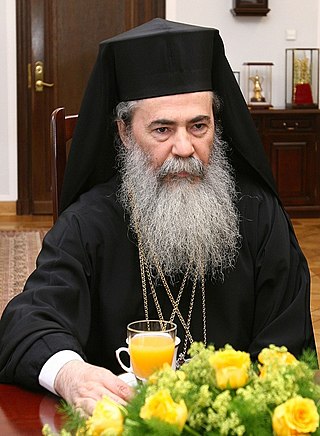Related Research Articles

The Greek Orthodox patriarch of Jerusalem or Eastern Orthodox patriarch of Jerusalem, officially patriarch of Jerusalem, is the head bishop of the Greek Orthodox Patriarchate of Jerusalem, ranking fourth of nine patriarchs in the Eastern Orthodox Church. Since 2005, the Eastern Orthodox patriarch of Jerusalem has been Theophilos III. The patriarch is styled "Patriarch of the Holy City of Jerusalem and all Holy Land, Syria, beyond the Jordan River, Cana of Galilee, and Holy Zion." The patriarch is the head of the Brotherhood of the Holy Sepulchre, and the religious leader of about 130,000 Eastern Orthodox Christians in the Holy Land, most of them Palestinians.
St. Flavian II of Antioch was the Patriarch of Antioch from 498 until his deposition and subsequent banishment in 512.
Theophanes the Confessor was a member of the Byzantine aristocracy who became a monk and chronicler. He served in the court of Emperor Leo IV the Khazar before taking up the religious life. Theophanes attended the Second Council of Nicaea in 787 and resisted the iconoclasm of Leo V the Armenian, for which he was imprisoned. He died shortly after his release.
George Syncellus was a Byzantine chronicler and ecclesiastical official. He had lived many years in Palestine as a monk, before coming to Constantinople, where he was appointed synkellos to Tarasius, patriarch of Constantinople. He later retired to a monastery to write what was intended to be his great work, a chronicle of world history, Ekloge chronographias, or Extract of Chronography. According to Anastasius Bibliothecarius, George "struggled valiantly against heresy [i.e. Iconoclasm] and received many punishments from the rulers who raged against the rites of the Church", although the accuracy of the claim is suspect.

Saint Ignatius Elias III was the Patriarch of Antioch, and head of the Syriac Orthodox Church from 1917 until his death in 1932.

Moran Mor Ignatius Peter IV, also known as Ignatius Peter III, was the Patriarch of Antioch, and head of the Syriac Orthodox Church from 1872 until his death in 1894. He is regarded by many as the architect of the modern church.
John X bar Shushan was the Patriarch of Antioch, and head of the Syriac Orthodox Church, from 1063/1064 until his death in 1072/1073.
Quriaqos of Tagrit was the Patriarch of Antioch, and head of the Syriac Orthodox Church, from 793 until his death in 817. He is commemorated as a saint by the Syriac Orthodox Church in the Martyrology of Rabban Sliba, and his feast day is 13 or 16 August.
Paul Antaki is the Melkite Greek Catholic titular archeparch of Nubia and auxiliary bishop.
Elias II or Eliya II may refer to:
Elias I of Antioch was the Patriarch of Antioch and head of the Syriac Orthodox Church from 709 until his death in 723. He is commemorated as a saint by the Syriac Orthodox Church in the Martyrology of Rabban Sliba, and his feast day is 3 November.
Julian I was the Patriarch of Antioch and head of the Syriac Orthodox Church from 591 until his death in 594/595. He is commemorated as a saint by the Syriac Orthodox Church.
Athanasius IV Salhoyo was the Patriarch of Antioch and head of the Syriac Orthodox Church from 986/987 until his death in 1002/1003.
Ignatius II was the Patriarch of Antioch and head of the Syriac Orthodox Church from 878 until his death in 883.
Elias II was the Patriarch of Jerusalem in 770–797. He was patriarch during the reign of Caliph Harun al-Rashid and during the Arab tribal wars in Palestine between the late 780s and 796. His patriarchate saw the plundering of the St. Chariton Monastery and the assault on the Mar Saba Monastery, in which some twenty monks were killed by tribal marauders. Prior to these attacks, Elias II penned and sent a letter to the Patriarch of Constantinople, known as the "reply of the Patriarchates in the East", in which he lamented the plight the Christians faced in his jurisdiction.
Joseph II of Jerusalem was the patriarch of the Church of Jerusalem from 981 to 983. Little is known of his life. It was during his episcopate that Sadaqah Ibn Bishr, the Patriarchal syncellus, was able to complete the renovation of the Church of the Holy Sepulchre that had been damaged by fire during riots in 966.
Thomas I of Jerusalem, also known in Persian as Tamriq, was the Patriarch of Jerusalem of the Church of Jerusalem from 807 to 821. Patriarch Thomas held a firm Orthodox theological position and opposed both the iconoclasts and the filioque. He is considered a saint, commemorated in May 16.
Basil of Jerusalem was the Patriarch of Jerusalem of the Church of Jerusalem from 821 to 842. During his episcopate, Basil actively opposed the iconoclasm that was supported by the Byzantine emperor Theophilus.
Theodosius of Jerusalem was Patriarch of the Church of Jerusalem from 864 to 879.
Elias of Jerusalem may refer to: